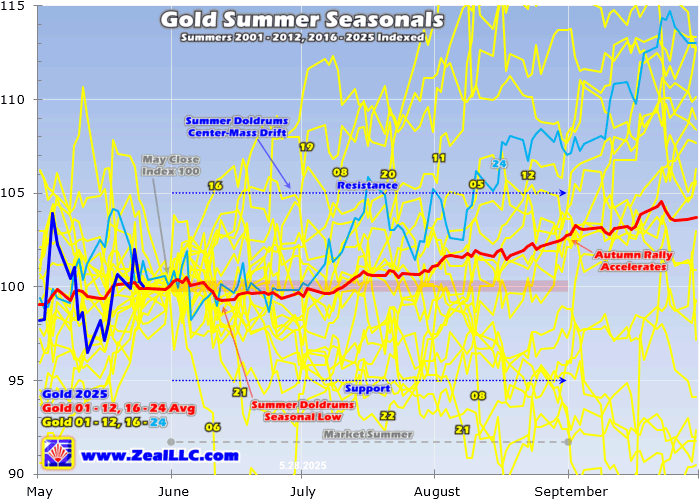Gold Summer Doldrums ‘25
Gold and its miners’ stocks are entering their weakest season of the year, early summers. Vacations and summer fun divert traders’ attention, leaving waning interest in markets. That usually weighs on demand for gold and gold stocks, so they tend to drift sideways to lower. June typically suffers the worst of these summer doldrums, with buying normally returning by mid-July. This creates good seasonal buying opportunities.
This doldrums term is very apt for gold’s traditional summer predicament. It describes a zone in the world’s oceans surrounding the equator. There hot air is constantly rising, spawning long-lived low-pressure areas. They are often calm, with little prevailing winds. History is full of accounts of sailing ships getting trapped in this zone for days or weeks, unable to make headway. The doldrums were murder on ships’ morale.
Crews had no idea when the winds would pick up again, while they continued burning through their limited stores of food and drink. Without moving air, the stifling heat and humidity were suffocating on those ships long before air-conditioning. Misery and boredom grew extreme, leading to fights breaking out and occasional mutinies. Being trapped in the doldrums was viewed with dread, it was a very trying experience.
Gold investors can somewhat relate. Like clockwork trudging through early summers, gold usually starts drifting listlessly sideways. It often can’t make significant headway no matter what trends looked like heading into June, July, and August. As the days and weeks grind on, sentiment deteriorates markedly. Patience is gradually exhausted, supplanted with deep frustration. So plenty of traders abandon ship, capitulating.
June and early July in particular have often proven desolate sentiment wastelands for gold and gold stocks, devoid of recurring seasonal demand surges. Unlike most of the rest of the year, the summer months simply lack any major income-cycle or cultural drivers of outsized gold investment demand. Seasonals aside, gold’s setup heading into summer 2025 is quite bearish after rocketing to extreme overboughtness.
Gold soared in recent months, blasting up 31.9% from mid-December to mid-April! Largely spearheaded by massive Chinese investment demand, gold achieved 24 new record closes in that short span. But that Chinese buying catapulted to frenzied extremes in April, spurred by Trump’s embargo-grade 145% tariffs on Chinese imports into the US! That threatened to shutter much of China’s important export-factory sector.
Chinese investors feared a serious recession hammering stock prices lower, so they flocked to gold fueling record gold-ETF capital inflows. Gold soared so far so fast that it hit a crazy-overbought extreme stretched 26.6% above its 200-day moving average in mid-April! That was only gold’s third 26%+ close since January 2011, an unsustainable anomaly. Overheated technicals and sentiment really needed rebalancing.
That can be accomplished faster through selloffs or slower through high consolidations. While the former was more probable after such epic overboughtness, gold has since vacillated between both outcomes. Initially after soaring to $3,421 in mid-April, gold fell 5.5% in a pullback. But a sharp V-bounce out of that soon fueled a marginal new record close of $3,422 in early May, with gold still running 1.243x its 200dma.
Then over the next week or so gold sold off hard pulling back another 7.1%. That was the second-largest selloff of gold’s mighty cyclical bull, which extraordinarily hasn’t seen a single 10%+ correction despite its outsized gains and longevity. Gold powered 88.1% higher over 19.0 months into mid-May! At the bottom of that latest pullback gold remained 14.4% above its 200dma, still just under extreme overboughtness at 1.150x+.
Yet right when a correction was within sight and the US and China decided to delay their huge reciprocal tariffs for 90 days to give negotiating time, gold surged back up to $3,360. That was 1.196x its 200dma, and just 1.8% under early May’s latest record close! So for the most part gold has consolidated high over these super-choppy past five-plus weeks. Gold has held on to its big gains, remaining really overbought.
That makes this year’s summer doldrums a bigger downside threat than usual. If Chinese investors join American ones in shifting their focus away from markets in June, gold could still roll over into a correction. Generally summer weakness is more pronounced the hotter gold and gold stocks were leading into the doldrums. Big pre-summer rallies really up the odds of mean-reversion sentiment-rebalancing selloffs.
Rather than worrying about any June selling, traders should embrace gold’s summer doldrums. Healthy selloffs are essential for maximizing cyclical bulls’ longevity and ultimate gains, normalizing psychology before greed grows excessive enough to prematurely slay them. These selloffs also offer good mid-bull buying opportunities. So instead of checking out in early summers, traders should be researching great stocks.
Quantifying gold’s summer seasonal tendencies during bull markets requires all relevant years’ price action to be recast in perfectly-comparable percentage terms. That is accomplished by individually indexing each summer’s gold prices to their last closes before, which are May’s final trading days. They are set to 100, then all summer gold price action is recalculated off those common indexed baselines.
So gold trading at an indexed level of 110 simply means it has rallied 10% from May’s final close, while 95 shows it is down 5%. This methodology renders all bull-market-year gold summers in like terms. That’s necessary since gold’s price range has been so vast, from $256 in April 2001 to $3,422 in May 2025. That span encompassed two secular gold bulls, the first soaring 640.1% over 10.4 years into August 2011!
Following that mighty juggernaut, gold consolidated high then started correcting into 2012. But the yellow metal didn’t enter formal bear territory down 20%+ until April 2013. That beast mauled gold on and off over several years, so 2013 to 2015 are excluded from these seasonal averages. Gold finally regained bull status powering 20%+ higher in March 2016, then its modest gains grew to 96.2% by August 2020.
Another high consolidation emerged after that, where gold avoided relapsing into a new bear despite a serious correction. Later the yellow metal started powering higher again, coming within 0.5% of a new nominal record in early March 2022 after Russia invaded Ukraine. So 2016 to 2021 definitely proved bull years too, with 2022 really looking like one early on. Then Fed officials panicked, unleashing market chaos.
Inflation was raging out of control thanks to their extreme money printing. In just 25.5 months following the March 2020 pandemic-lockdown stock panic, the Fed ballooned its balance sheet an absurd 115.6%! That effectively more than doubled the US monetary base in just a couple years, injecting $4,807b of new dollars to start chasing and bidding up the prices on goods and services. That fueled an inflation super-spike.
With big inflation running rampant, Fed officials frantically executed the most-extreme tightening cycle in this central bank’s history. They hiked their federal-funds rate an astounding 450 basis points in just 10.6 months, while also selling monetized bonds through quantitative tightening! That ignited a huge parabolic spike in the US dollar, unleashing massive gold-futures selling slamming gold 20.9% lower into early September.
That was technically a new bear market, albeit barely and driven by an extraordinary anomaly that was unsustainable. Indeed gold soon rebounded sharply, exiting 2022 with a trivial 0.3% full-year loss. Gold kept on powering higher, reentering bull territory up 20.2% in early February 2023! So I’m also classifying 2022 as a bull year for seasonality research. Gold’s modern bull years include 2001 to 2012 and 2016 to 2024.
When all gold’s summer price action from these modern gold-bull years is individually indexed and thrown into a single chart, this spilled-spaghetti mess is the result. 2001 to 2012 and 2016 to 2023 are rendered in yellow. Last summer’s action is shown in light-blue for easier comparison with this summer. Seeing all this perfectly-comparable indexed summer price action at once reveals gold’s center-mass-drift tendency.
These summer seasonals are further refined by averaging together all 21 of these gold-bull years into the red line. Finally gold’s summer-to-date action this year is superimposed over everything else in dark-blue, showing how gold is performing compared to its seasonal mean. Because this earlier doldrums essay’s data cutoff was Wednesday, 2025 price action is indexed to its close for now. Later I’ll update it to the 30th.
In modern-bull-year seasonal-average terms, gold tends to bottom on June’s 10th trading day down just 0.7% from May’s final close. That’s nothing, seemingly trivializing the summer doldrums. Through April and May up until Wednesday, gold’s average absolute daily moves in either direction have been a volatile 1.5%! Gold may very well get lucky this summer, only drifting modestly lower in June’s peak doldrums.
That happened last summer despite gold also soaring to extremely-overbought levels in mid-May. Gold stretched way up to 1.178x its 200dma then, and suffered a mere 5.7% pullback into early June. That left 2024’s summer-doldrums nadir down just 1.8% from May’s final close. Seeing gold keep drifting and weather this year’s doldrums consolidating high without any additional significant selling is the best-case scenario.
But boy June can get way uglier, especially after exceptional overboughtness. Nearly two decades ago in May 2006, gold skyrocketed to an epic 1.389x its 200dma! The resulting rebalancing reckoning out of that extreme was violent. Gold plummeted 21.9% into mid-June, leaving its summer-doldrums low 13.6% under May’s close! But May 2006 was far-more-speculative-mania-like for American traders than May 2025.
In the great majority of the time in modern bull-year summers, gold has mostly drifted within +/-5% of May’s close. Substituting in May 28th’s for now this year due to this essay’s timing, that implies a gold range of $3,129 to $3,458. The former would leave gold down 8.6% from early May’s latest record close, for the biggest pullback of this mighty cyclical bull challenging a correction. But that seems pretty optimistic.
Back in late April after gold soared to 1.266x its 200dma, I wrote an essay on that crazy overboughtness. As part of that analysis, I built a spreadsheet analyzing every 10%+ gold move either direction since way back in January 1971. Since the 1970s were so unique and wild as the US dollar can only be decoupled from gold once, I excluded that decade’s super-bulls as well as today’s similar monster which isn’t yet over.
Following the next-ten-largest gold bulls of the past half-century or so, gold corrected by an average of 15.5% in a fast 1.9 months! A similar rebalancing selloff today would hammer gold down near $2,892 sometime in these summer doldrums. Interestingly that would equate to 1.026x gold’s current 200dma. Those previous corrections in these next-ten-largest gold bulls averaged similar bottomings at 1.024x.
There are two major risk factors that could easily slam gold into correction territory. Waning Chinese investment demand is the first, and that seems to be underway according to the World Gold Council’s latest monthly update on it. In mid-May its Chinese analysts warned, “As we enter May, ETF demand in China remains positive yet slows notably compared to April.” That was driven by moderating trade-war tensions.
The second near-term threat to gold is the recently-extremely-oversold US Dollar Index bouncing hard in a big-and-fast mean-reversion rally. The past couple months’ high gold prices have coincided with low dollar ones. American gold-futures speculators who have outsized influence on gold price action due to that realm’s extreme leverage tend to watch the dollar’s fortunes for their trading cues and do the opposite.
Since gold’s latest record high in early May, every single trading day it has moved and closed in lockstep opposition to the USDX! More good trade-war news ending huge-tariffs threats could spark an overdue big dollar surge, as could better-than-expected major US economic data reducing Fed-rate-cut odds. Gold selloffs can happen fast. In the last two months alone, gold has suffered a bunch of large down days.
Those include big daily losses of 2.2%, 2.0%, 2.5%, 1.8%, 1.8%, 2.7%, 2.2%, and 1.7%! String a few of those together, and gold could be correcting inside of a couple weeks. While gold’s fundamentals remain very bullish and its larger secular bull has many years left to run, all bulls need periodic corrections to rebalance sentiment. These are essential and healthy, one step back paving the way for two more forward.
If another summer-doldrums selloff is in the cards for gold this year, getting it out of the way sooner would be better. Across all these modern bull years, gold has averaged 0.3% losses in June. But by mid-July gold’s strong autumn rally is usually getting underway, which averaged 5.2% gains in these same bull years by late September. Gold soon swings back to good average gains of 1.1% in July and 2.8% in August.
The gold miners are slaved to gold’s technical action, which both their earnings and stock prices amplify by 2x to 3x. For gold-stock summer seasonals, I’m using the older HUI gold-stock index which closely mirrors the GDX VanEck Gold Miners ETF far more popular today. Unfortunately GDX’s price history is insufficient to span these modern gold-bull years, as this leading sector ETF wasn’t born until May 2006.
Gold stocks’ summer seasonals naturally follow and leverage those of their metal. Since the HUI and GDX are functionally interchangeable with the same major gold-stock holdings, GDX tends to bottom on June’s 10th trading day 1.9% below May’s final close. In June, July, and August in these modern gold-bull years, GDX averaged gains of 0.2%, 1.6%, and 3.9%. June is the heart of gold stocks’ summer doldrums.
Again these long-term seasonal averages look mild, but gold stocks can suffer much-worse summers if gold sells off materially. 2021 is a good case in point, the worst recent summer for gold and its miners. Gold’s doldrums festered that year, the yellow metal didn’t bottom until early August 9.2% under May’s final close! The main reason was the US Dollar Index was starting to rally after grinding near secular lows.
Big gold-futures selling earlier that summer forced gold lower. Of course gold-stock traders didn’t like that, so they fled pounding GDX down 21.8% that summer by late August! That made for 2.4x downside leverage to gold, right in the middle of major gold stocks’ usual range. If gold sells off further in this current summer 2025, gold stocks are highly likely to similarly amplify its losses. So it’s prudent to be wary.
For a quarter-century we’ve extensively traded fundamentally-superior smaller mid-tier and junior gold stocks in our subscription newsletters. We refilled our trading books after gold’s post-election selloff into mid-November, then rode those positions to great gains as gold soared this spring. We tightened up our trailing stop losses as gold’s extreme overboughtness got crazy, resulting in many big realized gains since.
I’m excited to redeploy, as gold miners’ fundamentals are epically-bullish with these high prevailing gold prices. The GDX-top-25 gold stocks reported achieving their best quarter ever in Q1, with record revenues, unit profits, bottom-line earnings, operating cash flows, and cash treasuries! But regardless of how awesome they are faring today, gold stocks inevitably get sucked into any material gold selloffs for any reason.
So I’ve been actively researching great smaller gold miners to create a shopping list of the best, but have held off on redeploying. Gold still needs to bleed off more of its extreme overboughtness from April and May, either selling off deeper or drifting longer to rebalance sentiment and technicals. That process should mostly run its course over the next five weeks or so, likely forcing gold-stock prices considerably lower.
Successful trading demands always staying informed on markets, to understand opportunities as they arise. We can help! For decades we’ve published popular weekly and monthly newsletters focused on contrarian speculation and investment. They draw on my vast experience, knowledge, wisdom, and ongoing research to explain what’s going on in the markets, why, and how to trade them with specific stocks.
Our holistic integrated contrarian approach has proven very successful, and you can reap the benefits for only $10 an issue. We extensively research gold and silver miners to find cheap fundamentally-superior mid-tiers and juniors with outsized upside potential. Sign up for free e-mail notifications when we publish new content. Even better, subscribe today to our acclaimed newsletters and start growing smarter and richer!
The bottom line is gold is entering 2025’s summer doldrums, its weakest time of the year seasonally. Most of that slump is typically compressed into June, with gold recovering in July and August. Since gold recently soared to crazy-overbought extremes on frenzied Chinese buying, the odds for a doldrums selloff this year are much higher. This mighty gold bull needs a healthy rebalancing selloff before resuming again.
The likely catalysts are slowing Chinese gold demand or the oversold US dollar surging into an overdue mean-reversion rally. Both could be driven by waning trade-war fears, and the latter by key US economic data coming in better than expected lowering Fed-rate-cut odds. If gold’s high consolidation rolls over into a correction, the gold stocks will follow amplifying its losses. That would yield a good buying opportunity.
*********

















